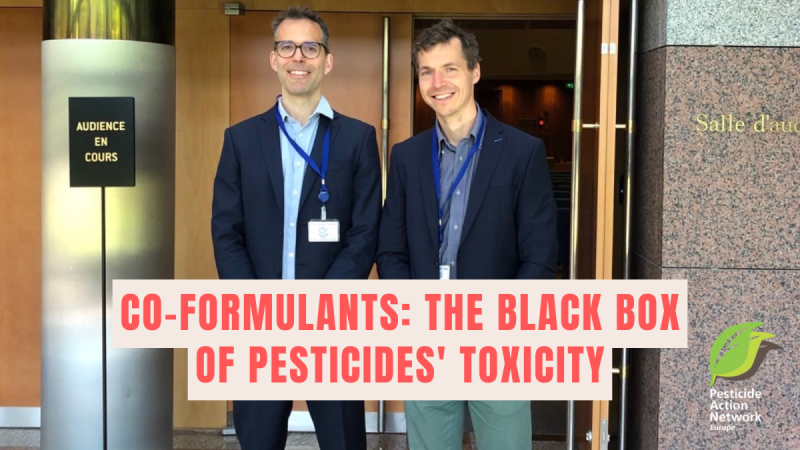Wednesday June 11th we took part in a hearing at the General Court of the EU in Luxembourg, questioning the lack of testing of co-formulants in pesticide products. We initiated this legal case in 2023. Co-formulants represent the majority of the ingredients of commercial pesticides, while usually only one active ingredient is assessed for their toxicity to humans, including their carcinogenicity or endocrine disrupting properties. Co-formulants are currently very poorly monitored and regulated.
According to the EU pesticides regulation (reg. 1107/2009/EC), co-formulants are substances that are not active ingredients and that are meant to increase the 'efficacy' of pesticide products. In reality, most co-formulants are powerful detergents (called surfactants/wetting agents/anti-foaming agents, etc.) that increase the toxicity of the active ingredient towards the target pest, but of course also to humans and other organisms. The pesticides regulation clarifies that the level of protection of human health and the environment against co-formulants must be the same as for pesticide active ingredients. However, this is not the case.
Scientific evidence shows that co-formulants can increase by several thousand-fold the toxicity of the active ingredient towards human cells. Indeed, surfactants help pesticide substances penetrate to the heart of our cells and damage them. Numerous co-formulants are also harmful per se: some are petrol derivatives with endocrine-disrupting or mutagenic or carcinogenic properties, others kill bees and other insects, fish, salamanders and frogs.
New regulation without force
In 2023, the European Commission published a new regulation on the detailed rules to identify unacceptable co-formulants (reg. 2023/574/EC). The Commission proposal was not truly improving the situation, as no mandatory toxicity data was requested to the industry, in order to properly assess these substances. In the frame of the public consultation, PAN Europe shared its position paper (1) and criticised this empty regulation. PAN Europe was in the view that the proposed rules were not in line with the high level of protection foreseen in the pesticides regulation. On the other hand, CropLifeEU, the pesticides industry umbrella organisation, applauded this regulation. (2)
Martin Dermine, PAN Europe's executive director, said: 'Some co-formulants are highly toxic substances like carcinogens or endocrine disruptors. Others have been proven to decimate bees. The Commission asks Member States to evaluate their toxicity without receiving any toxicity data, this does not make sense: it is like asking someone to make a cake without giving the person the necessary ingredients.'
Following the publication of the 'co-formulants regulation', PAN Europe decided to go to EU Court to challenge this ineffective piece of legislation. PAN Europe challenges three issues in this regulation. Firstly, the fact that no data requirement is demanded of the pesticide industry, in order for Member States to be able to carry out their work and assess the toxicity of co-formulants on health and the environment.
Second, PAN Europe challenges the fact that with this regulation, the European Commission places the burden of the evaluation of co-formulants on Member States. The regulation plans that the 27 Member States will be obliged to carry out a risk assessment of the thousands of co-formulants on the market. Carrying out 27 times the same work will lead to different interpretations and conclusions and paralyse the decision-making. PAN Europe asks the assessment to be carried out at EU-level by the European Food Safety Authority (EFSA) which has more expertise and means to do the work. PAN Europe also asks that the co-formulants regulation contains an obligation by Member States to take a formal decision in the risk assessment: with the current regulation, they are obliged to carry out a risk assessment of co-formulants, without data as mentioned previously, and without the obligation to conclude positively or negatively. This point is important to increase the accountability of regulatory authorities.
Third, PAN Europe challenges the fact that by placing the burden on the shoulders of Member States, the Commission abstracts itself from its legal obligation to regulate co-formulants, as is foreseen in the pesticides regulation, and transfers this prerogative to Member States only.
The case opposes PAN Europe to the European Commission, with the intervention of CropLifeEU in support of the Commission, and its pro-industry co-formulants regulation.
Critical questions for PAN Europe in court hearing
In the hearing before the General Court the three judges asked questions to the parties involved. Many questions were addressed to our lawyer, Professor Antoine Bailleux, who illustrated the health and environmental consequences of not regulating these toxic substances that are spread without control on our food and in the environment. Failure to regulate may be legally more complicated for judges than misapplying regulation. We will see in a few months how the questions translate into a judgment in this case.
Notes:
(1) Feedback from: Pesticide Action Network Europe - 18 November 2022
